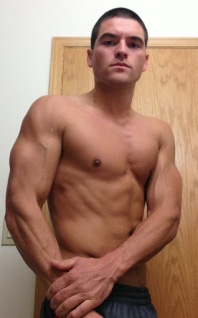
I remember when I first overheard a few coworkers talking about this “intermittent fasting” thing I thought it was the quickest way to look like a Kentucky Derby jockey. Needless to say, this was not desirable. Lean muscle is universally recognized as the goal for anyone seeking longevity, health, or an aesthetically pleasing physique. At the time of this initial introduction to “IF” I had been back to working out consistently for about 6-8 months, and the last thing I wanted to do was “waste away”, look emaciated, and lose my hard earned muscle.
The fitness industry says that you need to eat 6 meals a day to keep metabolism stoked and to keep the muscles from withering away from lack of an i.v. drip of protein. This is not true. Who knew? The body knows what it is doing.
As long as you are getting adequate total caloric intake, you’re body responds to the demands of lifting heavy things, just as it would if you took 3 hours a day to prepare 4 meals, 2 protein shakes, 3 snacks, and a Tupperware stash that would rival Jay Leno’s car collection.
So, if you’re ready to take the plunge and reap all the benefits, here’s you’re best “Day 1” plan:
The goal of my style of IF is to get to at least 16 hours without calories. It sounds crazy at first, right? Well, we will get 7-9 hours of that time period taken care of while we sleep. This example “transition” into IF is based on the typical schedule of waking in the morning, sleeping in the late evening.
7:30-8:00pm (the night before your first day of fasting)
This meal is quite a bit more crucial than I initially realized. The last meal lead into a daily fast really does make a difference.
Eat a healthy meal. Nothing completely out of the ordinary, but follow the next three points.
- Make this meal a little larger than what is normal for you.
- Make sure this meal contains plenty of healthy fats such as avocado, coconut oil, almonds, fish.
- Limit the amount of carbohydrates you consume, more explicitly, no sugar.No bread, either. Once entering the body, there’s not a big difference between the two. This means no fruit, either.
I have to include that I have not came across any research expressing why the approach of consuming healthy fats and minimal carb intake plays such a vital role in staving off that “starving to death” feeling that we have all experienced. I personally know it to be true from anecdotal evidence and experience of those who have transitioned to this eating style.
I surmise that this happens due to the over employment of insulin to regulate blood sugar spikes (because of the carb aka glucose aka sugars) intake which often occurs when the pancreas is told to pump in insulin to combat this flooding of sugar in the blood stream. The over secretion of insulin=blood sugar plummets=”O my god, I’m hungry.” Insulin regulation is a whole other story but for the purpose of this post, eat as described and you’ll have a much easier route to become an IFer.
5am-8am (the initial fast day)
Upon waking, drink two large glasses of cold water.
This is good practice for any day, but especially useful for today’s purpose. The stomach is only one portion of the complex satiety-hunger process. However, by drinking this large volume of water, the stretch receptors of the stomach send messages to the brain signaling a full stomach. It doesn’t completely trick the brain into feeling stuffed, but it sure helps.
Drinking black coffee is a daily routine for me and it’s hunger suppressant characteristics aid in trying to teach your body to remember how to use adipose fat tissue as fuel(instead of only glucose derived from carbs).
8am-12pm
If serious hunger strikes, you must move.
Air squats, a walk around the office, 15 pushups, walk around the office, chair dips, all get blood flow moving and signal to the body that energy MUST be produced. Hormone response to exercise forces the body to respond with stored energy. We never are unable to move, we are simply limited by the feeling that we wish not to move.
Once you’ve hit noon, you’ve made it! Your first day of IF. You have taken back control of your own body. You are no longer limited by your proximity to a refrigerator or convenience store.
Some people can easily go right into these 16hr/day fasts. Others, like myself, take some time to work up to this time period with 0 calories. Don’t be discouraged if you feel like you cannot make it passed a certain time. This is the first day, and if you are determined to make it until lunch without food, you will be able to. That being said, I was limited by the fact that I needed to be cognizant and responsive, so I took almost a week to lead up to the 16 hours. Once you regain your metabolic flexibility (the ability to switch between sugars and fat for energy) you’re good to go, and it feels easy going forward.
One other thing: Fasting means zero calories. People have said to me, “I only had a granola bar”, or “I’ve only eaten an apple today.” This does not constitute fasting, and from experience actually makes you feel more hungry.
I’ve got to include a disclaimer that if you have any reservations about your metabolic health (hypo-hyper glycemia, diabetes, etc.) or anything of the sort, consult your physician for guidance. Humans are designed to be able to go much longer than 16 hours without food but our modern lives paired with modern foods have caused millions of people to become carb addicted.
 Years ago my view of meditation was as follows; post-modern hippies sitting cross-legged, pointer finger and thumb lightly clinched, while reciting a deep bellied chant. These hippies were seeking mindfulness, clarity of thoughts, health, creativity, focus, inner peace, and harmony. While I now believe there may be some things to learn about my previous ideological views, I realize that meditation can be useful to everyone as nothing less than a non-pharmaceutical prescription. I became curious about these desirable traits attributed to meditation, but find myself often trying to understand the hows, the whys, and the whens, before I jump into unconventional styles of thought. Unconventional to my own experiences, at least. I wondered, am I to focus on something? Am I to focus on nothing? Maybe I’m supposed to just focus on focusing? I don’t bother with the insignificant inquisitions any longer. Why the change? Was it maturity and/or Clinical Trials? These two factors surely helped, but once I finally began to meditate without of the worry of doing it wrong, I found it empowering, tranquil, refreshing, and other associated adjectives. My own personal goal for meditation is just to stop and take a look at myself. I try to really enjoy the present moment. I (try to) slow my mind so there is but one chain of thoughts entering my conscious mind at a time, selectively choosing which thoughts to acknowledge, and which to discard. “Practicing meditation” is a quote you may sometimes hear. This is due to the fact that meditation takes time and is a skill that is harnessed and perfected. We each have our own view of meditation and it can be used for many purposes.
Years ago my view of meditation was as follows; post-modern hippies sitting cross-legged, pointer finger and thumb lightly clinched, while reciting a deep bellied chant. These hippies were seeking mindfulness, clarity of thoughts, health, creativity, focus, inner peace, and harmony. While I now believe there may be some things to learn about my previous ideological views, I realize that meditation can be useful to everyone as nothing less than a non-pharmaceutical prescription. I became curious about these desirable traits attributed to meditation, but find myself often trying to understand the hows, the whys, and the whens, before I jump into unconventional styles of thought. Unconventional to my own experiences, at least. I wondered, am I to focus on something? Am I to focus on nothing? Maybe I’m supposed to just focus on focusing? I don’t bother with the insignificant inquisitions any longer. Why the change? Was it maturity and/or Clinical Trials? These two factors surely helped, but once I finally began to meditate without of the worry of doing it wrong, I found it empowering, tranquil, refreshing, and other associated adjectives. My own personal goal for meditation is just to stop and take a look at myself. I try to really enjoy the present moment. I (try to) slow my mind so there is but one chain of thoughts entering my conscious mind at a time, selectively choosing which thoughts to acknowledge, and which to discard. “Practicing meditation” is a quote you may sometimes hear. This is due to the fact that meditation takes time and is a skill that is harnessed and perfected. We each have our own view of meditation and it can be used for many purposes.












